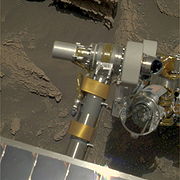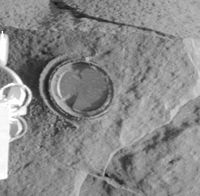
Rock Abrasion Tool
Encyclopedia


NASA
The National Aeronautics and Space Administration is the agency of the United States government that is responsible for the nation's civilian space program and for aeronautics and aerospace research...
’s twin Mars Exploration Rovers, Spirit
Spirit rover
Spirit, MER-A , is a robotic rover on Mars, active from 2004 to 2010. It was one of two rovers of NASA's ongoing Mars Exploration Rover Mission. It landed successfully on Mars at 04:35 Ground UTC on January 4, 2004, three weeks before its twin, Opportunity , landed on the other side of the planet...
(MER-A) and Opportunity
Opportunity rover
Opportunity, MER-B , is a robotic rover on the planet Mars, active since 2004. It is the remaining rover in NASA's ongoing Mars Exploration Rover Mission...
(MER-B), which landed on Mars
Mars
Mars is the fourth planet from the Sun in the Solar System. The planet is named after the Roman god of war, Mars. It is often described as the "Red Planet", as the iron oxide prevalent on its surface gives it a reddish appearance...
in January 2004. It was designed, developed and continues to be operated by Honeybee Robotics
Honeybee Robotics
Honeybee Robotics Spacecraft Mechanisms Corporation is a small spacecraft technology and robotics company located in Manhattan, New York. It was established in 1983 by Stephen Gorevan and Chris Chapman. Honeybee has particular expertise in developing and operating small mechanical tools used on...
LTD, a developer of specialized robots, automated technologies and related systems.
The RAT was the first machine to gain access to the interior of rocks on another planet. The RAT weighs 685 g (about 1.51 lbs), is 7 cm (2.76 inches) in diameter and 10 cm long (3.94 inches), about the size of a soda can. It uses a diamond dust and resin wheel spinning at 3000 rpm to drill a 45 mm diameter by 5 mm deep bore hole in Martian Rocks. The RAT then uses two brushes to sweep dust from the bore holes for closer scientific inspection. Its average power consumption is 30 watts.
There are five other instruments aboard both rovers, these are the Pancam (a camera), Mini-TES (an infrared spectrometer) for sensing targets at a distance, a Microscopic Imager, a Mössbauer spectrometer and an alpha particle X-ray spectrometer. The RAT provides these instruments with a smooth, clean surface from which they make more accurate observations.
The RAT was first used by Spirit on its 34th sol (6 Feb 2004). It was held up to the rock Adirondack, whereby it scraped to a depth of 2.85 mm over the course of 3 hours. Since then it has been used on numerous Martian rocks by both MER rovers.
The RAT was originally controlled from NASA’s Jet Propulsion Laboratory
Jet Propulsion Laboratory
Jet Propulsion Laboratory is a federally funded research and development center and NASA field center located in the San Gabriel Valley area of Los Angeles County, California, United States. The facility is headquartered in the city of Pasadena on the border of La Cañada Flintridge and Pasadena...
in Pasadena, California, but is now run by Honeybee Robotics LTD from their New York headquarters. The RAT is the first product of Honeybee Robotics LTD’s to be sent into space by NASA.

